Apple Announces The Apple Watch 4: Fully Custom SiP
by Andrei Frumusanu on September 12, 2018 11:30 PM EST- Posted in
- Mobile
- Apple
- Wearables
- Apple Watch Series 4
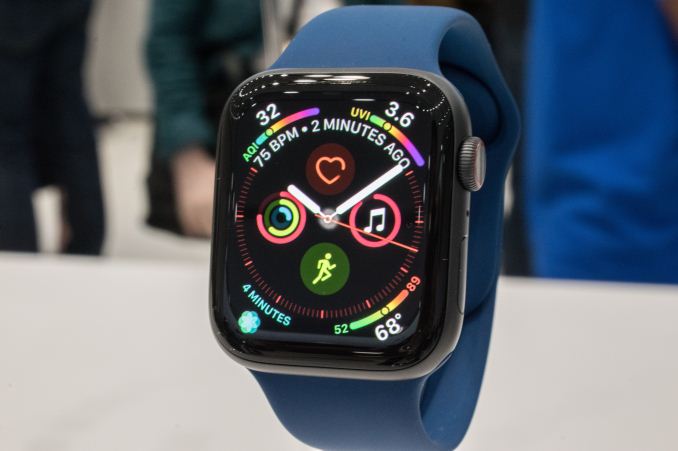
Today alongside the new iPhone XS, XS Max and the XR, Apple first introduced the new Apple Watch Series 4. The fourth generation of the watch sees a major revamp in its specifications and the most visible external design change to date.
Inside the new Apple Watch 4, we see Apple transition to a new SiP (Silicon in Package) design with a new S4 SoC containing for the first time a custom Apple designed CPU and GPU. We don’t have much information on the specifications here other than the new dual-CPU is 64-bit capable and is promised to perform twice as fast as it’s predecessors – which used Arm’s Cortex A7.
It’s to be noted that the 64-bit part of the new CPU might not be as clear as one might think, as there’s been some evidence (Credit @KhaosT) that the Watch might be running in ARM64_32 mode, which would be a 32-bit submode of AArch64 that allows for 32-bit pointers while retaining the ISA advantages of AArch64. Such a mode would be most optimal for a low-memory device such as smartwatch.
Prior generations of the Apple watch used a variation of an Imagination SGX core. For the S4 again Apple claims it’s a new custom GPU – again we don’t have any details here other than what Apple talked about in the presentation.
Finally the new S4 SiP includes new accelerometer and gyroscope functionality that has 2x the dynamic range in terms of measurable values, as well as able to sample data at 8x the speed. What this allows Apple to do is to collect a lot more data at higher accuracy and try to determine the scenario that you’re in. For example Apple claims the new watch is able to discern between falling, tripping and slipping just based on the movements that the person makes – whose detection is now enables by the new hardware sensor capabilities.
The new watch comes in 40 and 44mm sizes, and is fully compatible with prior generation Watch bands.
The core new characteristic of the new watch is the larger screen which now achieves a higher screen-to-body ratio on the watch. This is actually a pretty great improvement as the new screen feels a lot more pronounced.
To emphasize the new screen, Apple provides new watch faces with configurable information. Here the new watch allows for up to 8 complications which are at the disposal of the user. There’s also several new animated wallpapers available – these are pre-recorded videos that just play back on the watch face.
The new watch has also lost some of its thickness as it’s now 10.7mm versus the series 3’s 11.4mm. Here I’m still hoping one day we can see even thinner models, as it’s my personal least favourite aspect of smartwatches in general. Even though its thickness got reduced and it offers more performance and features, the new watch is said to maintain the same battery life longevity as its predecessors.
The sides of the watch have also changed quite a bit. On the left side we now have a larger speaker grill; Apple promises the new speaker to be a lot louder and surprisingly so for a watch. Unfortunately during the loud hands-on this was quite hard to evaluate.
On the right side we see the microphone being relocated between the button and the crown dial. The reasoning here is to reduce echo effects from the new more powerful speaker. The crown has been improved and now gives haptic feedback, trying to mimick the “clicking wheel” feel such as in more mechanical dials, or more aptly, the clicking of a mouse wheel when you scroll with it. The haptics here are enabled not by the crown itself, but by a vibration motor inside the watch.
On the back of the watch we don’t see much visible changes, however we now find a new improved optical heartrate sensor which is able to detect the heart rhythm.
What’s actually the most interesting in terms of the health monitoring capabilities of the new watch is that it actually includes for the first time ever a ECG (electrocardiogram) functionality in an over the counter consumer device. Here all you have to do while wearing the watch is to touch the crown – which serves as an anode and closes the loop created across your arms and heart.
Apple was very proud to be the first consumer device to enable this and had even received approval by the US FDA. It’s to be noted that this will beg some questions on how the feature will be implemented in other regions, as using and advertising such medical monitoring features might be disallowed if you don’t have regulatory approval.
Apple definitely is leading the smartwatch sector by a significant margin, and the company was even keen to point out that the Apple Watch is the most popular watch overall as well (Though that’s just because there’s no one dominating classic watch in a similar position).
The new Apple watch with GPS is available for $399 and the LTE variant comes in at $499 and are both available starting September 17th, with preorders starting this Friday the 14th. Overall I found the new Apple Watch 4 a lot more attractive than its predecessors – though it’s still a quite steep price point.


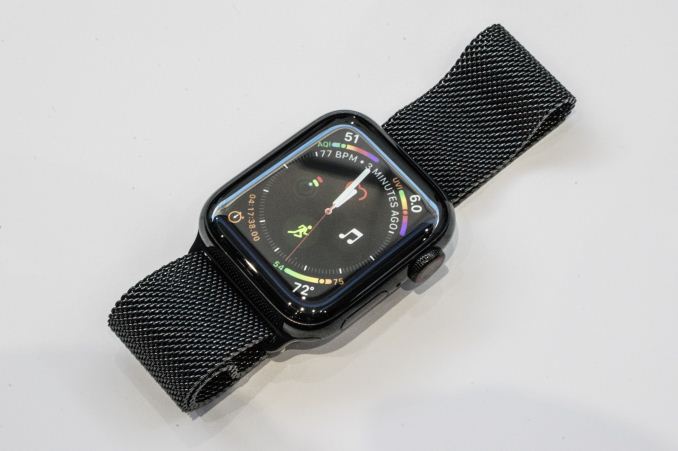
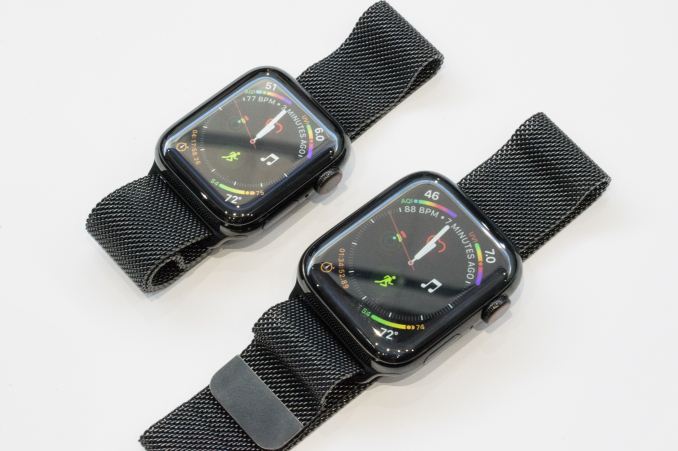
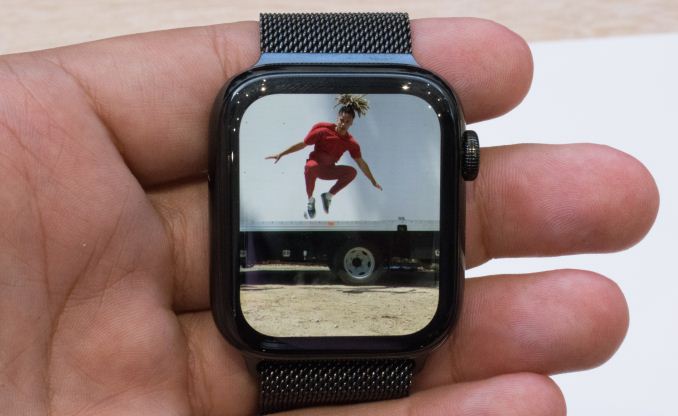
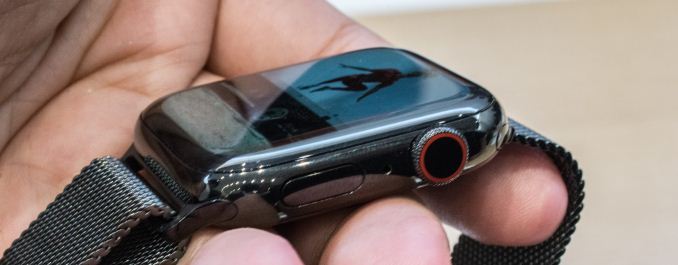









88 Comments
View All Comments
3DoubleD - Thursday, September 13, 2018 - link
It all depends on what claims Apple is making about the ECG and whether the ECG is being used to diagnose disease.If they are marketing it as the first smartwatch with an ECG *** not for medical use *** then sure, the FDA will give them the green light to sell it. If Apple was claiming to be able to diagnose heart disease with this device, it would be classified as a medical device and subject to strict regulatory standards. To this end, I'm struck that the article describes it as "The first consumer device...", which does not suggest to me that the Apple Watch is classified as a medical device and that the FDA merely approved their inclusion of an ECG and their marketing it as a consumer device for non-medical use. I could be wrong though as I'm only going off the information that was included in this article.
id4andrei - Thursday, September 13, 2018 - link
You are correct. The ECG feature on the AW is FDA "cleared" and not FDA "approved". There is a major distinction between these two.melgross - Thursday, September 13, 2018 - link
Apple and the FDA have been talking for years. The president of the American Heart Association came up and talked about why this was an important development. If this didn’t really work, that would be a bad move.id4andrei - Thursday, September 13, 2018 - link
It's not about not working, it's about how it is working. The Apple theater presentation is marketing and in no way indicative of an FDA approval process.Tams80 - Monday, September 17, 2018 - link
That doesn't change the fact that it is FDA 'cleared', but not FDA 'approved'. These are very specific terms in this context, not the general uses of those words.There is a big difference between 'cleared' and 'approved'. 'Approved' devices have undergone much more stringent testing.
V900 - Thursday, September 13, 2018 - link
It’s NOT approved by the FDA.It’s cleared by the FDA, which basically means that it does sorta what it said it does, and won’t explode or kill you in some other way.
This is completely different from a device that is FDA approved for medical use. Those are thoroughly tested to ensure that they are accurate enough to be used in a clinical setting.
FDA Cleared: Does it take an ECG? Does it harm you?
FDA Approved: Does it take an acccurate ECG.
repoman27 - Thursday, September 13, 2018 - link
"Does it take an accurate ECG" is Class II (Performance Standards), which still does not require the approval process."Is it implanted or controlling a person's heart rhythm" is Class III.
melgross - Thursday, September 13, 2018 - link
You’re totally wrong. It’s an FDA approved and classified heart rate and ekg system.id4andrei - Thursday, September 13, 2018 - link
Why are you fighting this when even the Verge issued an article explaining the deal with the FDA clearance in relation to FDA approval. These are not just contextual synonyms. It's a cool feature, it's just not medical grade.repoman27 - Thursday, September 13, 2018 - link
Why are you continuing to spread FUD and citing The Verge instead of the FDA’s own perfectly comprehensible synopsis of how they classify and regulate medical devices ( https://www.fda.gov/medicaldevices/resourcesforyou... )?It’s a cool feature that has met 100% of the FDA’s requirements for a Class II device. The requirement to pass the full FDA approval process does not distinguish whether or not a device is “medical grade” (which AFAIK is not a term defined by the FDA) , it’s simply the standard for devices that could directly harm or kill you.